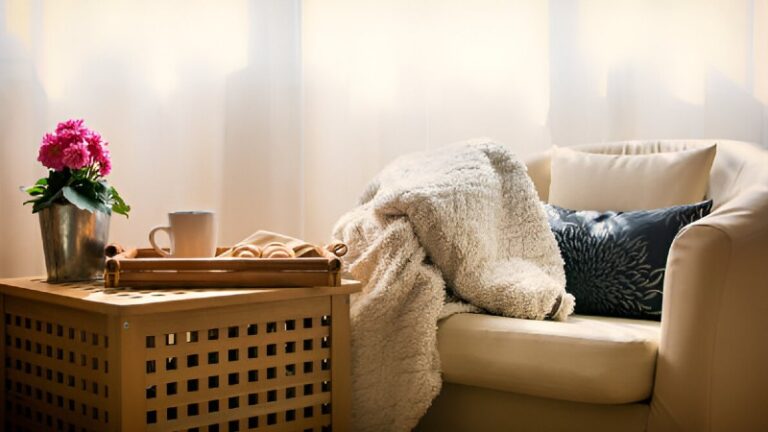In an era where home has become both a sanctuary and a workspace, creating a cozy space is more than a design trend—it’s a lifestyle choice. Comfort at home impacts mood, productivity, and overall well-being. But achieving that perfect balance between aesthetic appeal and physical comfort can feel overwhelming.
Why Coziness Matters
Coziness isn’t just about soft pillows and warm blankets. Research shows that the environments we inhabit directly influence mental health. According to a study by the American Psychological Association, individuals who feel comfortable and safe in their living spaces report lower stress levels and improved emotional well-being.
Moreover, a cozy environment encourages mindfulness and relaxation. Whether it’s a quiet evening with a book, a casual coffee break, or hosting family and friends, comfort in your home affects both your personal enjoyment and social experiences.
Step 1- Assess Your Space and Needs
Before purchasing cozy items, it’s essential to analyze your living space and lifestyle:
- Room Functionality: Is the room primarily for relaxation, work, or entertaining?
- Existing Layout: Identify areas for furniture, lighting, and decor adjustments.
- Personal Comfort Preferences: Do you prioritize tactile comfort, warmth, or visual serenity?
Example: A reading nook might require a plush armchair, layered blankets, and soft ambient lighting, while a small home office may benefit from ergonomic furniture with cozy accessories like a throw rug or heated pad.
Step 2- Shop for Textures That Elevate Comfort
Layering textures is a hallmark of a cozy space. When shopping, look beyond soft fabrics and consider the overall tactile experience.
Top Fabric Choices for Maximum Comfort
| Fabric | Key Benefit | Example Item |
|---|---|---|
| Bouclé | Soft, textured, visually plush | Curved swivel chair or upholstered headboard |
| Fleece | Warmth and softness for throws or cushions | Oversized throw blanket |
| Velvet | Luxurious feel and rich color saturation | Accent pillows or footstools |
| Knit Cotton | Lightweight and breathable, ideal for layering | Decorative pillows and blankets |
Tip: Combine at least two different textures in one area for depth. For instance, a velvet pillow on a knit throw layered over a boucle chair enhances both visual appeal and tactile comfort.
Step 3- Lighting (The Unsung Hero of Cozy)
Lighting shapes the perception of warmth and intimacy. Harsh overhead lighting can make even the softest room feel uninviting, while carefully curated light sources elevate comfort.
Practical Lighting Tips
- Use warm-toned bulbs for all lamps and overhead fixtures.
- Incorporate dimmers to adjust brightness based on time of day or activity.
- Layer lighting with table lamps, floor lamps, string lights, or candle warmers.
- Consider smart lighting for personalized schedules that mimic natural sunlight.
Example: A corner reading nook with a floor lamp, string lights above a bookshelf, and a candle warmer on a side table can create a layered, cozy ambiance that encourages lingering.
Step 4- Color Palette for Comfort
Colors evoke emotion. Warm, earthy tones naturally induce relaxation, while cool tones can feel refreshing but less intimate.
Recommended Cozy Color Palettes
- Warm Neutrals: Beige, cream, taupe – promote calm and versatility.
- Earthy Tones: Terracotta, sage green, soft browns – add natural warmth.
- Deep Accents: Burgundy, navy, forest green – provide richness and depth.
Tip: Use accent pillows, blankets, or rugs to experiment with bold or seasonal colors without overwhelming your space.
Step 5- Furniture Selection for Maximum Comfort
Furniture is the backbone of a cozy space. Choose pieces that balance comfort, functionality, and style.
Furniture Guidelines
- Soft Edges: Rounded corners and plush upholstery reduce visual rigidity.
- Scale Appropriately: In small rooms, opt for multifunctional furniture to save space without sacrificing comfort.
- Dedicated Zones: Create distinct areas for lounging, reading, or working to structure your room efficiently.
Example: In a studio apartment, a loveseat paired with a small coffee table and layered rug can delineate the living area, while a foldable desk doubles as a workspace and decorative surface.
Step 6- Incorporating Personal Touches
Accessories make a space feel lived-in and inviting. Think beyond generic decor items and focus on pieces that resonate personally.
Suggestions for Personal Cozy Accessories
- Family photos in stylish frames
- Favorite books stacked or displayed
- Indoor plants or fresh flowers for natural texture and color
- Handcrafted or artisanal objects that tell a story
- Aromatherapy: candles, diffusers, or incense to add warmth and comfort
Example: A scented candle with a soft vanilla aroma can complement a velvet armchair and knit throw, creating a multi-sensory cozy experience.
Step 7- Layering Rugs and Flooring for Warmth
Flooring is often overlooked when shopping for comfort. Rugs not only add warmth but also define spaces and improve acoustics.
Tips for Choosing Cozy Rugs
- Opt for rugs with different pile heights to add tactile dimension.
- Layer smaller rugs over larger neutral rugs for visual depth.
- Choose non-slip backing for safety and durability.
Example: Layering a soft jute rug with a plush, high-pile wool accent rug under a coffee table enhances both comfort and visual interest.
Step 8- Integrating Technology Without Losing Comfort
Modern technology can enhance comfort without compromising the cozy aesthetic. Items like electric fireplaces, heated throw blankets, and smart thermostats provide convenience and warmth.
Tech-Friendly Cozy Tips
- Electric fireplaces double as decor and heat source.
- Smart lighting and climate control maintain optimal comfort throughout the day.
- Wireless speakers allow soft background music to enhance the atmosphere.
Example: A smart thermostat paired with a heated throw blanket and subtle ambient lighting ensures you can maintain a warm, inviting space year-round.
Step 9- Shopping Strategy for Cozy Living
When buying for comfort, a strategic approach ensures you invest in items that truly enhance coziness.
Cozy Shopping Checklist
- Start with key zones: seating, sleeping, and lounging areas.
- Prioritize tactile comfort (pillows, throws, upholstered furniture).
- Layer in secondary elements: rugs, lighting, accessories.
- Consider sustainability: durable materials reduce waste and enhance long-term comfort.
- Mix functional and aesthetic items for balance.
Cozy Living and Well-Being
| Factor | Impact on Well-Being | Source |
|---|---|---|
| Soft lighting | Reduces stress by 15% | Journal of Environmental Psychology, 2023 |
| Textured fabrics (plush, fleece, velvet) | Improves comfort satisfaction by 20% | International Journal of Interior Design, 2022 |
| Natural elements (plants, flowers) | Boosts mood and reduces anxiety by 12% | Frontiers in Psychology, 2021 |
Conclusion
Creating a cozy space is both an art and a science. It combines texture, lighting, color, furniture, personal touches, and smart technology to produce an environment that is aesthetically pleasing and emotionally comforting. When shopping for comfort, prioritize tactile materials, multi-sensory experiences, and items that reflect your personal style.
Remember: Coziness is not about excess; it’s about intention. Even small spaces can become inviting retreats when layered thoughtfully with the right fabrics, colors, lighting, and accessories. By following these strategies, your home can evolve into a sanctuary where relaxation and comfort are always within reach.
Start small, invest thoughtfully, and let your personal tastes guide the creation of a space that feels truly yours.
Frequently Asked Questions (FAQs)
What are the easiest ways to make a home feel cozy?
Simple additions like plush blankets, layered pillows, soft rugs, and warm ambient lighting can instantly create a cozy atmosphere. Incorporating personal touches and scented candles also enhances comfort.
How do I shop for comfort when decorating my home?
Focus on tactile fabrics (like velvet, boucle, and fleece), ergonomic furniture, layered textures, and lighting options. Prioritize items that combine functionality with a welcoming aesthetic.
Can small rooms be cozy too?
Absolutely! Use multi-functional furniture, warm paint colors, small rugs, and strategic lighting. Accessories like plants, throw blankets, and candles make even compact spaces inviting.
What role does lighting play in creating a cozy space?
Lighting sets mood. Opt for soft, warm bulbs, dimmers, string lights, or candle warmers instead of harsh overhead lights. Layering different light sources adds depth and comfort.
Are colors important for coziness?
Yes. Warm neutrals, earthy tones, and deep accent colors create visual warmth and relaxation. Accent pieces like pillows, rugs, and blankets are an easy way to experiment with cozy colors.
How can I make a space multi-sensory cozy?
Combine soft textures, ambient lighting, soothing scents, and gentle sounds like music or nature effects. Engaging multiple senses increases the perception of comfort and relaxation.
Do plants help make a space cozy?
Yes, indoor plants or flowers bring life, texture, and color to a room. They also improve air quality and add a natural calming element to any space.


